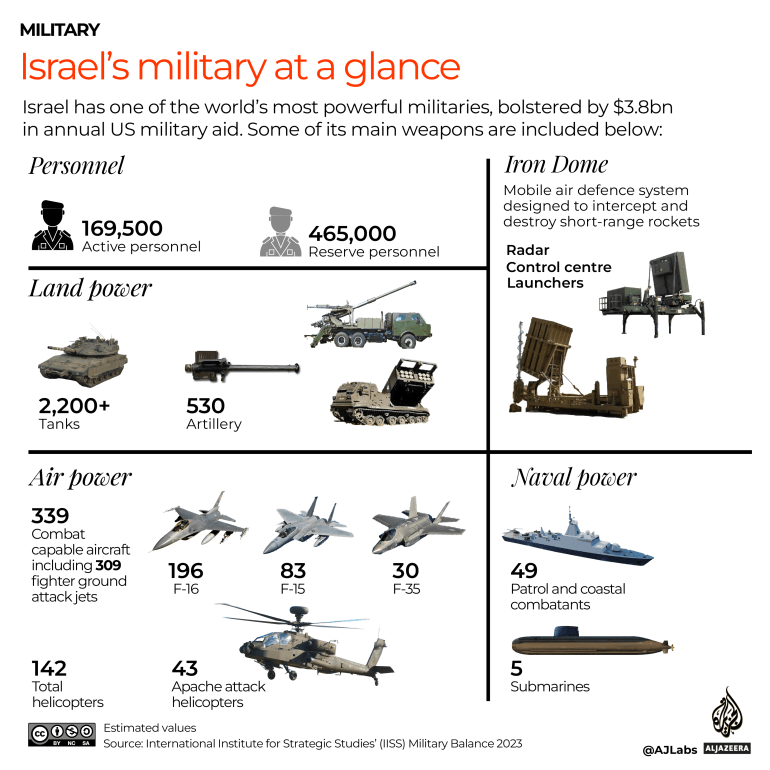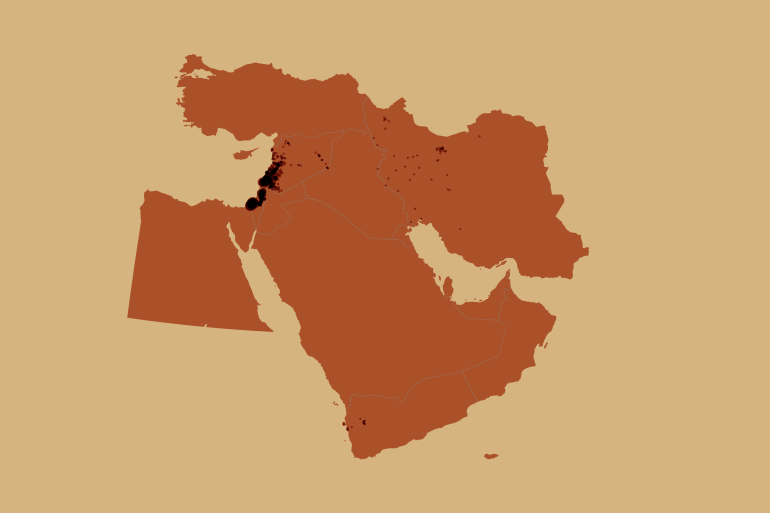Mapping Israel’s expanding battlefronts across the Middle East
Israel has launched nearly 35,000 attacks across five countries over the past 20 months.

By Mohamed A. HusseinPublished On 25 Jun 202525 Jun 2025
A fragile ceasefire remains in place between Israel and Iran, one day after US President Donald Trump announced a truce, ending 12 days of fighting that erupted following Israeli strikes on Tehran’s nuclear and military sites.
An analysis of data from the Armed Conflict Location and Event Data Project (ACLED) shows that between October 7, 2023, and just before Israel attacked Iran on June 13, 2025, Israel carried out nearly 35,000 recorded attacks across five countries: the occupied Palestinian territory, Lebanon, Syria, Yemen, and Iran.
These attacks include air and drone strikes, shelling and missile attacks, remote explosives, and property destruction.
The majority of attacks have been on Palestinian territory with at least 18,235 recorded incidents, followed by Lebanon (15,520), Syria (616), Iran (58) and Yemen (39).
Israel’s long-range air war
While the bulk of Israel’s attacks have concentrated on nearby Gaza, the occupied West Bank, and Lebanon, its military operations have also reached far beyond its immediate borders.
Israeli fighter jets have extended their reach by hundreds and even thousands of kilometres, striking targets about 550km (roughly 340 miles) away deep inside Syria, as well as approximately 1,500km (900 miles) away in Iran, and Yemen, up to 2,000km (1,200 miles) away. These long-distance strikes have significantly widened the geographic scope of the conflict, marking a shift towards more regionally expansive military engagement.
These operations have been made possible by Israel’s fleet of advanced US-supplied aircraft, including F-15 and F-16 fighter jets, as well as the stealth-capable F-35 – the most sophisticated combat aircraft in Israel’s arsenal. The country has also relied heavily on drones for surveillance and targeted strikes.

The map below shows the locations and quantity of Israeli attacks carried out between October 7, 2023, and June 13, 2025, in five countries up to 2,000km (1,200 miles) away.
Advertisement
Attacks on Gaza
After more than 628 days of relentless bombardment, blockade, and ground operations, Israel’s devastating assault in Gaza, widely described by many experts, human rights organisations, and international observers as genocide, is continuing.
According to the latest casualty figures from the Palestinian Ministry of Health in Gaza, at least 56,077 people have been confirmed killed and 131,848 injured.
Thousands more are feared dead, buried under the rubble.

Attacks on the occupied West Bank
Israel is applying many of the tactics used in its war on Gaza to seize and control territory across the occupied West Bank.
On January 21, just one day after a ceasefire took effect in Gaza, Israeli forces launched a large-scale military campaign across several cities in the northern occupied West Bank. The UN agency for Palestinian refugees (UNRWA) described it as “by far the longest and most destructive operation in the occupied West Bank since the second intifada in the 2000s.”
According to an analysis by the British research group Forensic Architecture, Israel has used building demolitions, armoured bulldozers, and air strikes to establish a permanent military presence in areas such as Jenin, Nur Shams and Tulkarem refugee camps. Satellite imagery shows widespread destruction, with entire neighbourhoods flattened and roads reconfigured to facilitate troop movements and surveillance.
The United Nations estimates that these operations have displaced at least 40,000 Palestinians. Over the past 20 months, Israeli forces and settlers have killed nearly 1,000 Palestinians across the occupied West Bank, including more than 200 children.
Israel-Lebanon cross-border attacks
On November 27, 2024, a ceasefire between Israel and Hezbollah came into effect, bringing an end to nearly 14 months of cross-border fighting that killed thousands of people.
As in Gaza and the occupied West Bank, Israeli attacks left widespread destruction in their wake, damaging numerous villages in southern Lebanon and entire neighbourhoods in Beirut.
Between October 7, 2023, and October 18, 2024, Israel, Hezbollah, and other Lebanese groups exchanged more than 13,600 cross-border attacks. Of these, approximately 83 percent (11,238 incidents) were carried out by Israel.

Attacks on Syria
Since December 10, 2024, just two days after the stunning collapse of more than 53 years of the al-Assad family, Israel has waged a campaign of aerial bombardment that has destroyed much of Syria’s military infrastructure, including major airports, air defence facilities, fighter jets and other strategic infrastructure.
Over the past six months, Israeli forces have launched more than 200 air, drone or artillery attacks across Syria, averaging an assault roughly every three to four days, according to ACLED.
The map below shows the ACLED-recorded Israeli attacks between December 8 and May 30.
Advertisement
Attacks on Yemen
Israel has also targeted Houthi-controlled infrastructure in Yemen, including Sanaa International Airport, Hodeidah Port, and several power stations. These strikes, which intensified in late 2024 and continued into 2025, are intended to weaken Houthi military capabilities following their missile and drone attacks on Israel in solidarity with Palestinians in Gaza.


Attacks on Iran
On June 13, 2025, Israel initiated a major escalation by launching a large-scale series of air and drone strikes deep into Iranian territory. This marked a significant shift in the conflict, as Israel targeted multiple sites across Iran, including military installations, weapons depots, and infrastructure linked to Iran’s regional influence and missile capabilities.
Using open source intelligence, including publicly circulated images and videos on social media, media reports, as well as visual identification of destroyed locations, Al Jazeera’s fact-checking unit, Sanad, has mapped some key Israeli and US strikes on Iran, as well as major Iranian attacks on Israel.
These attacks are shown on the maps below.

